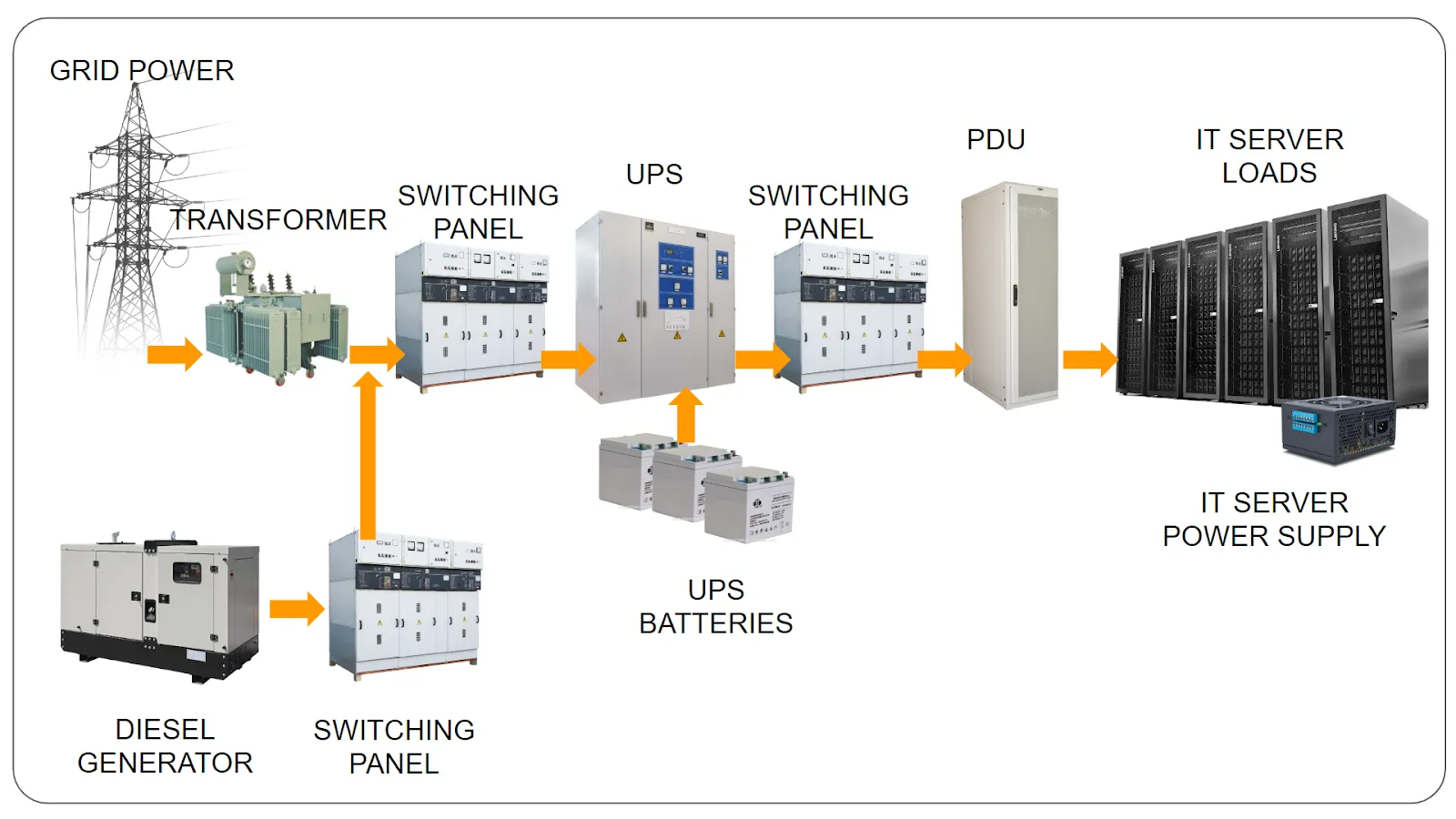Power
The power supply of every large data center starts with a connection to the main electrical grid which is provided by the local power company. To ensure uninterrupted operation even in the case of a large-scale power outage, data centers are typically connected to at least one diesel or gas backup generator.
The electricity from both the local power company and the backup generator is delivered with a medium voltage and is then transformed by one or more transformers to low voltage.
Data Center Power Components
Switching Panels that house fuses, circuit breakers, and ground leakage protection units, take the low-voltage electricity and distribute it to a number of endpoints, such as Uninterrupted Power Supply (UPS) systems or load banks. Additionally, the switching panels manage the incoming power from the main grid and can start the backup generator when they detect a power outage.
Instead of distributing low voltage power directly to sensitive computer electronic components and systems, switching panels pass it through an Uninterrupted Power Supply (UPS) system, which provides short-term power when the input power source fails and protects critical components against voltage spikes, harmonic distortion, and other common power problems.
Most UPS systems are designed to provide power for at least 5 minutes on maximum load during an outage. During those 5 minutes, the backup generation has enough time to make multiple attempts to start and take over the load from the UPS system.
Power Usage Effectiveness (PUE)
PUE is a figure that represents the ratio of power available to a data center vs. the power consumed by IT equipment. PUE is an expression of efficiency; this number can reveal how much power servers are using and how much is being used on non-server/non-IT tasks. The best PUE a data center can have is 1: an ideal situation, with no extra energy use.
Electrical Power Basics
The three most basic units in electricity are voltage (V), current (I, uppercase "i") and resistance (R). Voltage is measured in volts. Current is measured in amps and resistance is measured in ohms. Current is equal to the voltage divided by the resistance or I = V/R. This is known as Ohm's law.
Electrical power is measured in watts. In an electrical system power (P) is equal to the voltage multiplied by the current.
AC and DC Power
- Alternating current (AC) and direct current (DC) are two types of current (or voltage) used by electricity.
- AC current generally operates at 120 or 240 volts and is considered "traditional" power, which is used by grids around the world. It can be transformed into different voltages quite easily. AC current "changes direction" frequently, up to 60 times per second (also known as Hertz or Hz).
- DC current is a bit harder to quantify. Unlike AC, it remains constant and doesn't change direction. It's commonly associated with batteries or stored power such as that in a UPS. A car battery might run at 12 volts for instance. Some electrical systems such as telecommunications equipment run directly on DC power. A laptop will work off DC power if on battery.
Uninterrupted Power Supply (UPS) systems/Load Banks
- An UPS helps to “clean up” the electricity by ensuring that issues like surges don’t impact equipment. Each one is responsible for supplying power to a number of breakers.
- UPS systems also serve as an initial backup, in case of a power outage or similar issue. A typical UPS can provide power to servers and breakers for up to five minutes. This should provide enough time to get a backup generator going immediately following an outage or similar issue with the wider electric grid.
Generators
Supplementing a battery-based UPS with an emergency generator should be considered by all data center operators. Beyond disaster protection, the role of a backup generator to provide power is important when utility providers consider summer rolling blackouts and brownouts. In a rolling blackout, power to industrial facilities is often shut down first.
Important Considerations When Deploying a Generator
- Generator Size. When sizing a generator, it is critical to consider the total current IT power load as well as expected growth of that IT load. Consideration must also be made for facility supporting infrastructure (i.e. UPS load) requirements. The generator should be sized by an engineer, and specialized sizing software should be utilized.
- Fuel Type. The most common types of generators are diesel and gas. There are pros and cons to both as diesel fuel deliveries can become an issue during a natural disaster and gas line feeds can be impacted by natural disasters. Making the right choice for your data center generator depends on several factors. The fuel type needs to be determined based upon local environmental issues, (i.e. Long Island primarily uses natural gas to protect the water aquifer under the island), availability, and the required size of the standby/emergency generator.
- Deployment Location. Where will the generator be installed? Is it an interior installation or an exterior installation? An exterior installation requires the addition of an enclosure. The enclosure may be just a weather-proof type, or local building codes may require a sound attenuated enclosure. An interior installation will usually require some form of vibration isolation and sound attenuation between the generator and the building structure.
- Exhaust and Emissions Requirements. Today, most generator installations must meet the new Tier 4 exhaust emissions standards. This may depend upon the location of the installation (i.e. city, suburban, or out in the country).
- Required Run-time. The run-time for the generator system needs to be determined so the fuel source can be sized (i.e. the volume of diesel or the natural gas delivery capacity to satisfy run time requirements).







